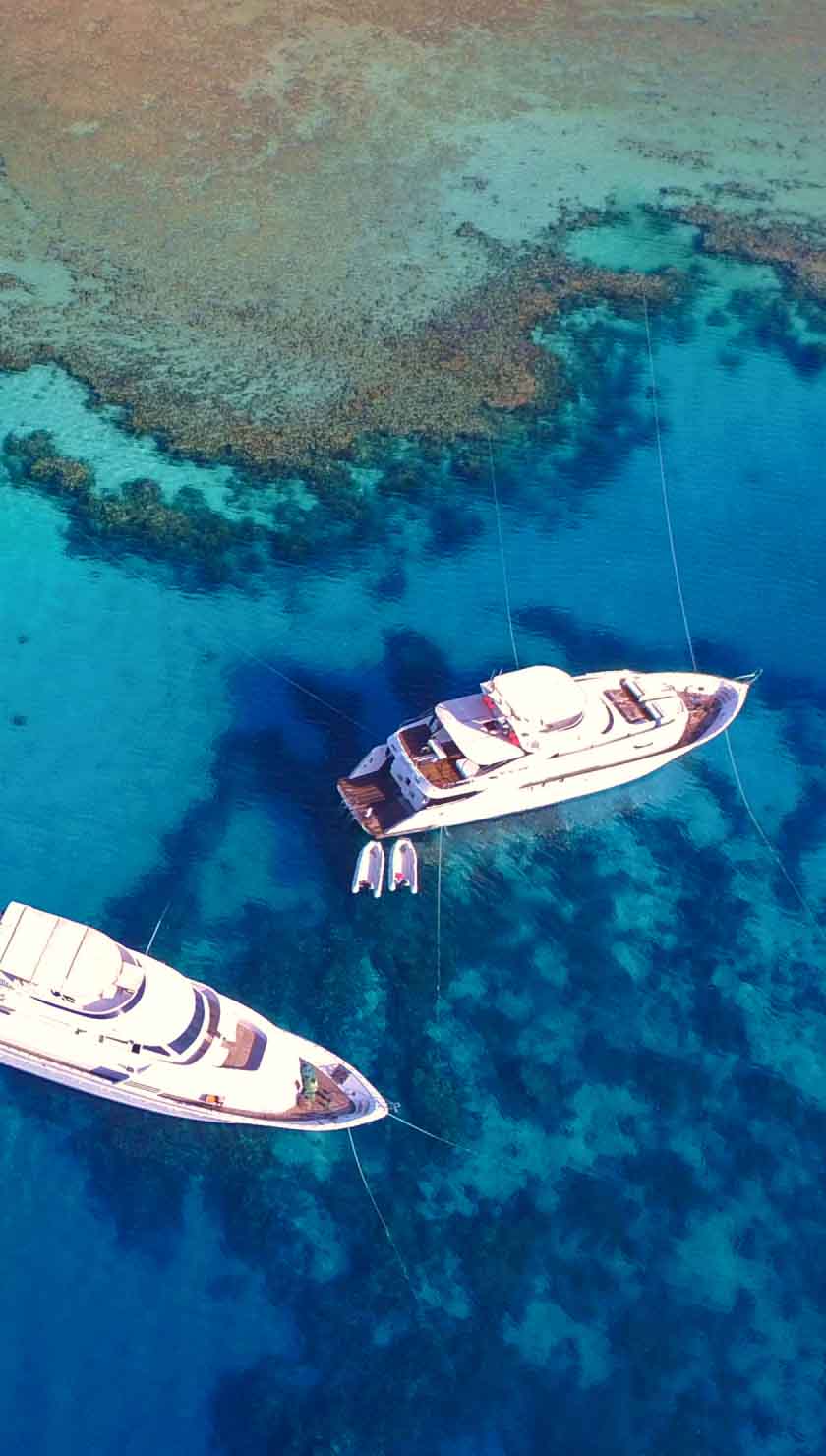Liveaboard Diving in Wolf Island
What to expect on a Wolf Island Liveaboard.
Wolf and Darwin islands are the most remote in the Galapagos archipelago. They sit over 160 kilometers/100 miles from the main island of Isabella on the Darwin-Wolf volcanic ridge. Wolf Island is named after the famous geologist Theodor Wolfe and is the more southerly of the two. The waters around Wolf Island have been recognized as some of the best dive sites in the world for many years.
The shape of the ocean floor means nutrient-rich currents flow around the island, bringing a huge array of sea life with it, including, of course, the larger pelagics. This spectacular parade of wildlife includes shoals of thousands of hammerheads, Galapagos sharks, tiger sharks, dolphins, and, in season, the magnificent whale sharks.
The island is closed to land visits, and the surrounding waters are highly protected. Due to the threat of illegal fishing, the Galapagos National Park Service has a dedicated floating barge, the 'Tiburon Martillo', close to the two islands. Along with a fleet of patrol boats and a surveillance aircraft, this barge helps deter finning boats drawn here by the sheer numbers of sharks in this jewel of the Galapagos Marine Park.
Daily Schedule
Morning
Early mornings are a stable feature of any Galapagos liveaboard, and once again, you will be up before 6 am for a light breakfast and maybe a coffee. The dive briefing will be highly informative although it might be hard to concentrate when you start hearing things like 'shoals of hammerheads', 'tiger sharks', 'loggerhead turtles', 'dolphin pods' and 'the occasional orca'. Try to keep up, though; the conditions in Wolf and Darwin can be some of the roughest, and the currents are very strong, so you will want to know what is happening. If you haven't already, your BCD will be fitted with a GPS location device just in case.
You will be dropped at the first dive site by the Panga tender. Which sites you visit are very weather and current dependant. If conditions are good, the first up is usually El Derrumbe and The Landslide. Here is a huge rock reef where you can look out into the blue and see the iconic hammerhead shoals passing by, hundreds strong. The dive will normally be around 50-60 minutes, and you still won't want to come up. Don't worry, after a proper breakfast and surface interval you will be dropped back at The Landslide for dive two and more amazing diving.
Afternoon
If the first half of the day is spent at the Landslide, you will move on to The Cave or Shark Bay after lunch. The choice of sites will be at the mercy of the conditions, but either way, you are in for two amazing dives whichever you visit. The pangas will drop you off and pick you up from the main boat for both dives.
Evening
During the warm season, the fourth dive can be scheduled as a night dive instead of an afternoon. For the rest of the year, the liveaboard will anchor up for the night or, if conditions permit, start sailing to Darwin Island. Either way, stay on the deck as much as possible; there is always much to see. Dolphin pods are often still around, and huge red kites often come and hitch a ride on the handrails of the boat.
Wolf Island Underwater
Hammerheads, Galapagos sharks, tiger sharks, mantas, tuna, dolphins, the list goes on. Wolf has everything divers visit Galapagos for, it is truly breath-taking diving. The landslide is a boulder-strewn reef which, you guessed it, resembles a landslide. This reef falls into the blue, and you can sit on the edge here, hold on, and witness one of the most amazing aquatic shows on earth. You will be surrounded by more sharks, turtles, and shoals of rays than you ever imagined. The landslide is also a great place to get close to the hammerheads. If you wait on the reef, they often swim up so close you could almost touch them.
The Cave is a stunning cavern and a series of swim-throughs with beautiful, soft white corals. This is a great place to see hammerheads and the shy Galapagos sharks. The current here is strong, making outside the caves the ideal hunting ground for tuna and almaco jacks.
Shark Bay is again home to hammerhead sharks, tiger sharks, and legions of turtles. The bay starts around 10 meters / 33 ft. and is shallower than other dives so divers can play with friendly sea lions. Further along, around 20 meters / 65 ft., you can see hammerheads and shoals of rays. The current here is high, and the swell is quite strong, especially close to the shore, which can often lead to an unexpected drift dive.
Top Tips for Wolf Island
- The current is strong, and the reefs are covered in barnacles, so wear gloves for protection. Also, watch out for hogfish always biting at loose barnacles, even if your hand is in the way.
- When hammerheads are on the reef, stay low and as still as possible, and you will get some real close-ups.
- The conditions can be rough at Wolf's surface, and pulling yourself back on the panga is a challenge. Stick to the back of the boat where the inflatable is lower.
- If the current eases, slip out into the blue for your safety stop, chances are you will run into shoals of sharks and sometimes dolphins.
Getting to Wolf Island
Wolf is usually the second stop for liveaboards after Punta Carrion, and the sail is an evening and overnight sail. The waters can be a little wild in places, but don't worry; this is what Galapagos liveaboards are built for. When you arrive, you will start to feel how remote and special this place is. Sitting up on the deck for an early coffee, you can see the pods of dolphins surrounding the island, a host of sea birds, and rays breaching if you are lucky.











